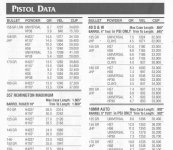jejb
Member
I have a big supply of Clays, built up from many years of shooting 10-15K rounds of trap a year. Wanting to start using it up in my handgun loads, so pulled out my (older) Hodgon reloading book and loaded up 150 rounds of .40 with 180 Berry's JFP and the recommended 4.4 gr of Clays. Normally, I'd only load a small batch to try of a new load, but I guess I got carried away, since it was listed in a Hodgon manual, and not some recipe I picked up on the internet.
Went to the range with the first 50 and they are snappy! Accurate, but a hand ringing load. So when I got home, I went on the Hodgon sight and see the highest they now recommend is 3.5 grs of Clays, which makes for a very low velocity round. I may give it a try, as I like how soft Clays shoots in my 9's.
So I spent an hour yesterday with the bullet puller hammer and the 100 rounds of hot ammo. Next time, I'll confirm from more than one source before I try a new load.
Went to the range with the first 50 and they are snappy! Accurate, but a hand ringing load. So when I got home, I went on the Hodgon sight and see the highest they now recommend is 3.5 grs of Clays, which makes for a very low velocity round. I may give it a try, as I like how soft Clays shoots in my 9's.
So I spent an hour yesterday with the bullet puller hammer and the 100 rounds of hot ammo. Next time, I'll confirm from more than one source before I try a new load.


